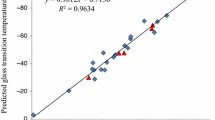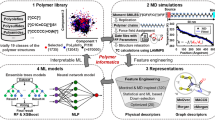Abstract
Fluorine-containing polymers belong to high-performance polymers with unique chemical and physical properties that are not observed with other organic polymers. In this article, three structural parameters were used to correlate with glass transition temperature Tg values for 52 fluorine-containing polybenzoxazoles. The descriptors obtained directly from the structures of repeating units can reflect the chain stiffness (or mobility). Back propagation artificial neural network (ANN) and multiple linear regression (MLR) analysis were used in the study. The final optimum neural network with [3-1-1] structure produced a training set root mean square (rms) error of 2.35 K (R = 0.980) and a test set rms error of 2.30 K (R = 0.978). The statistical results indicate that the ANN model given here has better predictive capability than other existing models.





Similar content being viewed by others
References
Bicerano J (2003) Encyclopedia of polymer science and technology. Wiley, New York
Katritzky AR, Sild S, Lobanov V, Karlson M (1998) J Chem Inf Comput Sci 38:300
Van Krevelen DW (1990) Properties of polymers. Elsevier Science, New York
Bicerano J (1996) Prediction of polymers properties, 2nd edn. Marcel Dekker, New York
Katrizky AR, Rachwal P, Law KW, Karelson M, Lobanov VS (1996) J Chem Inf Comput Sci 36:879
Yu XL, Yi B, Wang XY, Xie ZM (2007) Chem Phys 332:115
Mattioni BE, Jurs PC (2002) J Chem Inf Comput Sci 42:232
Chen X, Sztandera L, Cartwright HM (2008) Int J Intell Syst 23:22
Hougham G, Cassidy PE, Johns K, Davidson T (1999) Fluoropolymers I. Kluwer Academic/Plenum Publishers, New York
Lee JK, Kim JH, Kim YJ (2003) Bull Korean Chem Soc 24:1029
Пpиaлкo BП (1995) Handbook of polymer physical chemistry, vol 2. China Petrochemical Press, Beijing (trans: Yan J, Zhang Y)
Yu XL, Yi B, Liu F, Wang XY (2008) React Funct Polym 68:1557
Yu XL, Yi B, Wang XY (2008) Eur Polym J 44:3997
Yu XL, Yi B, Wang XY (2008) J Theor Comput Chem 7:953
Jurs PC (1996) Computer software applications in chemistry, 2nd edn. Wiley, New York
Yu XL, Wang XY, Li XB, Gao JW, Wang HL (2006) Macromol Theory Simul 15:94
Author information
Authors and Affiliations
Corresponding author
Rights and permissions
About this article
Cite this article
Ning, L. Artificial neural network prediction of glass transition temperature of fluorine-containing polybenzoxazoles. J Mater Sci 44, 3156–3164 (2009). https://doi.org/10.1007/s10853-009-3420-0
Received:
Accepted:
Published:
Issue Date:
DOI: https://doi.org/10.1007/s10853-009-3420-0




